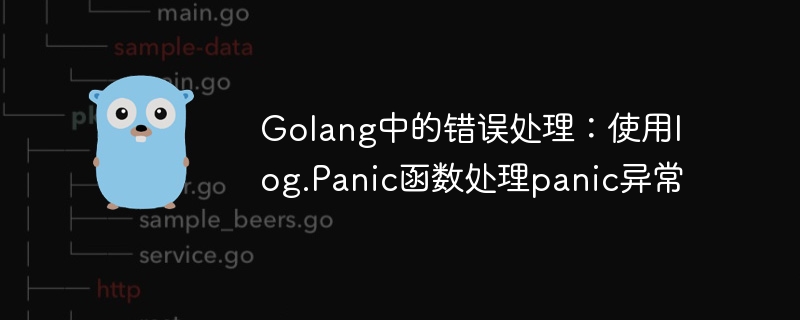

Error handling in Golang: Use log.Panic function to handle panic exceptions
In Golang, error handling is an important part of writing high-quality code. In addition to general error handling mechanisms, Golang also introduces panic and recovery mechanisms to handle more serious exceptions. This article will introduce how to use the log.Panic function to handle panic exceptions.
In Golang, panic is a very serious abnormal situation. When the code encounters an error that it cannot handle, it triggers panic and immediately aborts the execution of the program. When the program encounters panic, it will first execute any defer statements of the current function, then execute each defer statement in reverse order along the function call stack, and finally the program will print out the panic information and exit.
In order to better handle panic exceptions, Golang provides the log.Panic function. The function of the log.Panic function is to output an error message to the console and trigger a panic exception. This is useful when testing, debugging, and troubleshooting issues. The following is some sample code that uses the log.Panic function to handle panic exceptions:
package main
import (
"log"
)
func main() {
defer func() {
if err := recover(); err != nil {
log.Panic("发生了panic异常:", err)
}
}()
divideNumbers(10, 0)
}
func divideNumbers(a, b int) {
if b == 0 {
log.Panic("除数不能为0")
}
result := a / b
log.Println("结果:", result)
}In the above sample code, we use the defer statement to wrap an anonymous function. This anonymous function captures panic exceptions by calling the recover function. If a panic exception occurs in the program, the recover function will return a non-nil value, indicating that an exception occurred. We can determine whether a panic exception occurred by judging whether the return value of the recover function is nil.
When a panic exception occurs, we can output the error message through the log.Panic function and trigger the panic exception. In this example, we tried to perform digital division. If the divisor is 0, a panic exception will be triggered. We use the log.Panic function to output the error message: "The divisor cannot be 0".
When the code is executed, we can see that the error message is output on the console: "A panic exception occurred: the divisor cannot be 0", and then the program terminates immediately.
Using the log.Panic function to handle panic exceptions can help us locate and debug problems. It can provide detailed error information and the code location that caused the panic exception. By using the log.Panic function appropriately, we can handle exceptions better and make our code more robust and reliable.
To summarize, this article introduces how to use the log.Panic function to handle panic exceptions in Golang. The log.Panic function can output error information and trigger panic exceptions, helping us locate and debug problems in the code. Proper handling of panic exceptions is an integral part of writing high-quality code.
The above is the detailed content of Error handling in Golang: Use log.Panic function to handle panic exceptions. For more information, please follow other related articles on the PHP Chinese website!
 How to solve 0xc000409 error
How to solve 0xc000409 error
 How to solve the WerFault.exe application error
How to solve the WerFault.exe application error
 How to define variables in golang
How to define variables in golang
 What are the data conversion methods in golang?
What are the data conversion methods in golang?
 What are the commonly used libraries in golang?
What are the commonly used libraries in golang?
 What is the difference between golang and python
What is the difference between golang and python
 The difference between Sass and less
The difference between Sass and less
 What are the differences between c++ and c language
What are the differences between c++ and c language
 What does c# mean?
What does c# mean?




